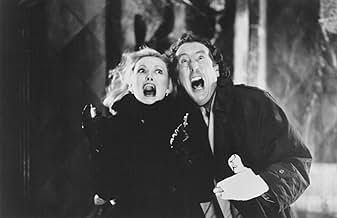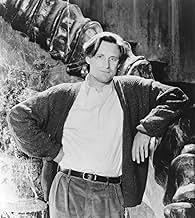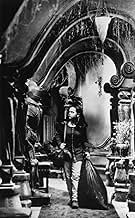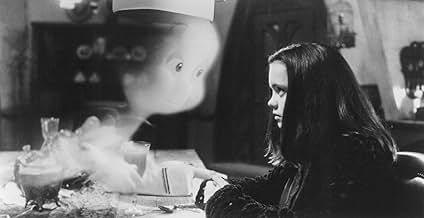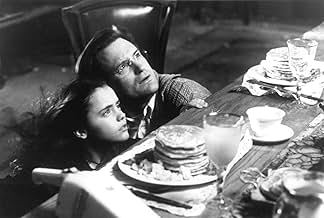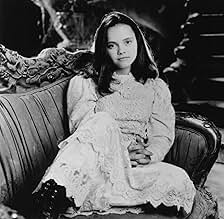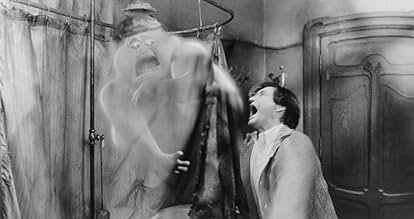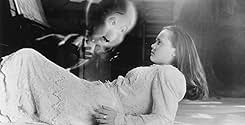Ein paranormaler Experte und seine Tochter schlafen in einem verlassenen Haus, das von drei schelmischen Geistern und einem freundlichen bevölkert ist.Ein paranormaler Experte und seine Tochter schlafen in einem verlassenen Haus, das von drei schelmischen Geistern und einem freundlichen bevölkert ist.Ein paranormaler Experte und seine Tochter schlafen in einem verlassenen Haus, das von drei schelmischen Geistern und einem freundlichen bevölkert ist.
- Regie
- Drehbuch
- Hauptbesetzung
- Auszeichnungen
- 5 Gewinne & 5 Nominierungen insgesamt
Malachi Pearson
- Casper
- (Synchronisation)
Fred Rogers
- Mr. Rogers
- (Archivfilmmaterial)
- (as Mr. Rogers)
Doug Bruckner
- Reporter
- (Synchronisation)
- (as Douglas J.O. Bruckner)
Joe Nipote
- Stretch
- (Synchronisation)
Joe Alaskey
- Stinkie
- (Synchronisation)
Brad Garrett
- Fatso
- (Synchronisation)
John Kassir
- The Crypt Keeper
- (Synchronisation)
Empfohlene Bewertungen
Forget the story. Forget the characters; forget even the kids and rent this just to be able to see Whipstaff Manor.
For me a film can be rewarding if just one element (in practical terms, it has to be an element I can recognize) is best in class. Here, it is the absolutely engaging set.
At the end of the 19th century, a style of art, essentially a fad, swept over Europe: Art Nouveau. This focused on natural forms and continuous lines. Done well in drawing and sculpture, its quite charming. At the same time, there was a crisis in architecture as the first real architects sought solutions to how internal space affects the psyche. For only a decade or so, architects tried to employ art nouveau in their work.
The problem is that the two just don't naturally mix: it's as if someone tried to do a swimmingpool production of Hamlet. But two geniuses partly succeeded in a few experiments: Horta in Brussels and Gaudi in Barcelona. In their lives their experiments were rejected by the public and critics. Today, they are among only a few valued gems of modern architectural history we have.
So much for background. What we have in Whipstaff Manor is a reworking of Gaudi, with some elements of Horta in entry and staircase. This is notable for a couple reasons:
---The primary mission of a film is to convey a tone, ideally an unfamiliar one. Sometimes cinematography is the tool of reliance, sometimes costumes, sometimes surreal plot twists, rarely acting posture. Rarely, rarely is the set the star. The goal of Gaudi was to (in a very literal sense) raise spirits by the form of the space. See how you feel in the bedroom/corridor and `livingroom' spaces. The attic was done by a lesser talent and the cellar isn't part of this discussion. But the main house draws on some deeply spooky center of the mind.
---The second notable comment is the sheer difficulty of what the set designers have done. Gaudi, an absolute master, had difficulty pulling off what he did. Here, the Casperites had an even greater challenge: when I go in a space, the relationship between me and the space is intimate; just a simple dialog. But when the space is presented through a medium, the designers have to dramatically exaggerate elements so the combined effect appears `normal.' Its the same as with what actors must do as compared to ordinary people you encounter; but an environment is more complex, more multidimensional, less semiotically loaded than a person. Mastering this greater palette of form is remarkable, and that's before you even accommodate the physical needs of production (camera placement, sound wiring...)
Check this out; it's interesting. Just based on the set, I place this in my best films list.
For me a film can be rewarding if just one element (in practical terms, it has to be an element I can recognize) is best in class. Here, it is the absolutely engaging set.
At the end of the 19th century, a style of art, essentially a fad, swept over Europe: Art Nouveau. This focused on natural forms and continuous lines. Done well in drawing and sculpture, its quite charming. At the same time, there was a crisis in architecture as the first real architects sought solutions to how internal space affects the psyche. For only a decade or so, architects tried to employ art nouveau in their work.
The problem is that the two just don't naturally mix: it's as if someone tried to do a swimmingpool production of Hamlet. But two geniuses partly succeeded in a few experiments: Horta in Brussels and Gaudi in Barcelona. In their lives their experiments were rejected by the public and critics. Today, they are among only a few valued gems of modern architectural history we have.
So much for background. What we have in Whipstaff Manor is a reworking of Gaudi, with some elements of Horta in entry and staircase. This is notable for a couple reasons:
---The primary mission of a film is to convey a tone, ideally an unfamiliar one. Sometimes cinematography is the tool of reliance, sometimes costumes, sometimes surreal plot twists, rarely acting posture. Rarely, rarely is the set the star. The goal of Gaudi was to (in a very literal sense) raise spirits by the form of the space. See how you feel in the bedroom/corridor and `livingroom' spaces. The attic was done by a lesser talent and the cellar isn't part of this discussion. But the main house draws on some deeply spooky center of the mind.
---The second notable comment is the sheer difficulty of what the set designers have done. Gaudi, an absolute master, had difficulty pulling off what he did. Here, the Casperites had an even greater challenge: when I go in a space, the relationship between me and the space is intimate; just a simple dialog. But when the space is presented through a medium, the designers have to dramatically exaggerate elements so the combined effect appears `normal.' Its the same as with what actors must do as compared to ordinary people you encounter; but an environment is more complex, more multidimensional, less semiotically loaded than a person. Mastering this greater palette of form is remarkable, and that's before you even accommodate the physical needs of production (camera placement, sound wiring...)
Check this out; it's interesting. Just based on the set, I place this in my best films list.
After you get through the stresses of your day... your job, the hassles of daily life, all the stressers that are out there daily, it seems great to sit back and enjoy something that will take you out of that for a little while. If you watch the news and read the papers every day like I do, it gets to you after a while...the young soldiers being killed in Iraq, all the election BS that we are being bombarded with right now...all or most of the news is downright depressing. That creates an important place for a movie like this...one that can make your life a little less serious for a while. I've always been a Christina Ricci fan, going back to the Addams Family when she was only 11 years old. She was a great actress even at that young age. You could tell that she would go far as an actress. The personality was there...it set her apart from her peers. At the age of 15, she continues to do a great job in Casper...she is very believable.
Sometimes, in this troubled world where violence and negative things seem to be the norm, a nice little movie like this can go a long way toward making your day a little brighter. Some of my other "feel good" movies are Patch Adams, all the Superman movies, the Robocop series, and good old Babe. Thanks for reading this. Feel free to reply with an email.
Sometimes, in this troubled world where violence and negative things seem to be the norm, a nice little movie like this can go a long way toward making your day a little brighter. Some of my other "feel good" movies are Patch Adams, all the Superman movies, the Robocop series, and good old Babe. Thanks for reading this. Feel free to reply with an email.
I saw it first for Christina Ricci and, I admitt, I was seduced by her work.
I saw it as a beautiful and, for many reasons, useful film about friendship.
And the scene of dance of Casper and Kat remains the basic good point , with fairy tale sparkles.
A film for entire family, preserving a sort of very fair ingenuity, reminding small truths and defining , in smart manner, the lost of loved other.
Sure, a naif comedy.
But charming in profound sense, not less for gentle remind of the real needs of every from us.
I saw it as a beautiful and, for many reasons, useful film about friendship.
And the scene of dance of Casper and Kat remains the basic good point , with fairy tale sparkles.
A film for entire family, preserving a sort of very fair ingenuity, reminding small truths and defining , in smart manner, the lost of loved other.
Sure, a naif comedy.
But charming in profound sense, not less for gentle remind of the real needs of every from us.
A ghost-whispering paranormal expert and his daughter (Bill Pullman and Christina Ricci) move into a dilapidated mansion on the coast of Maine that's haunted by a friendly ghost and three mischievous ones. Cathy Moriarty plays the venal heir of the mansion and Eric Idle her assistant.
"Casper" (1995) delivers the goods if you're in the mood for a "spooktacular" Goosebumps-like horror film that's fun & silly and not scary at all. It's like Scooby-Doo but without the dog and the teens are tweens. "Monster Night" (2006) and "Ghostbusters" (1984) are other reference points, but I prefer "Monster Night," which has a similar plot, but is all-around more entertaining (even though it cost significantly less) and has a superior assortment of good-lookin' women, young and older. With "Caspar" there's Moriarty, but she plays the biyatch antagonist. There's also ricci, but she was only 14 during shooting, although she's effective in the role.
The movie runs 1 hour, 40 minutes and was shot at Universals City, California, with establishing shots of Rockport, Maine.
GRADE: B-/C+
"Casper" (1995) delivers the goods if you're in the mood for a "spooktacular" Goosebumps-like horror film that's fun & silly and not scary at all. It's like Scooby-Doo but without the dog and the teens are tweens. "Monster Night" (2006) and "Ghostbusters" (1984) are other reference points, but I prefer "Monster Night," which has a similar plot, but is all-around more entertaining (even though it cost significantly less) and has a superior assortment of good-lookin' women, young and older. With "Caspar" there's Moriarty, but she plays the biyatch antagonist. There's also ricci, but she was only 14 during shooting, although she's effective in the role.
The movie runs 1 hour, 40 minutes and was shot at Universals City, California, with establishing shots of Rockport, Maine.
GRADE: B-/C+
I don't view films as if I'm watching them as the intended audience; I watch them for myself. And that's why I found it odd at how engrossed I was when I watched this film for the first time at the age of eighteen. Aside from the great gothic flair of the mansion, two superbly placed cameos, and nice laughable black humour from the "trio," the film took off because of its emotional core. It's something that a youngster can really get into, but also anyone who finds it sad that a child can die. When Casper plays with his toys, I just wanted to start crying. This eternal child--lost and stuck in an age of mystery and wonder. And yet, he's smitten with a girl--he's starting to go through puberty. And it's just so sad . . . and beautiful.
And then there's the father, and his sway into the afterlife, his daughter's plight, her struggle with her wish to help Casper. It's all so simple and written for kids, but I was so engrossed by the romanticism of it all.
The villains mostly butt into the greatness of all of it, but you just have to grant that in a kid's picture. And now comes my but . . . in the end, when the mother does appear, she's supposed to be this amazing, angelic, deux es machinal, she floats through the stain glass window, her long hair flows around her, her gown flows all around her but--what the hell! why is her dress such a deep red!? she looks like satan! Oh well. Bad costume choice made a really bad moment. But mostly, I loved this film for it's good parts, despite the childishness of much of it.
And then there's the father, and his sway into the afterlife, his daughter's plight, her struggle with her wish to help Casper. It's all so simple and written for kids, but I was so engrossed by the romanticism of it all.
The villains mostly butt into the greatness of all of it, but you just have to grant that in a kid's picture. And now comes my but . . . in the end, when the mother does appear, she's supposed to be this amazing, angelic, deux es machinal, she floats through the stain glass window, her long hair flows around her, her gown flows all around her but--what the hell! why is her dress such a deep red!? she looks like satan! Oh well. Bad costume choice made a really bad moment. But mostly, I loved this film for it's good parts, despite the childishness of much of it.
Wusstest du schon
- WissenswertesThis is the first feature film to have a fully computer-generated visual effects character in a leading role.
- PatzerIn the classroom, Casper ties Amber's shoelaces together before anyone else's. When Amber stands up to protest the party being at Kat's house instead of hers, she doesn't trip over them. She sits back down, but when the bell rings and she gets up, she trips.
- Zitate
Dr. Raymond Stantz: [runs out of the house frantic] Who you gonna call? Someone else.
- Crazy CreditsThe globe in the Universal logo fades into a full moon above Whipstaff Manor.
- VerbindungenEdited into Casper: Deleted Scenes (2003)
- SoundtracksCasper The Friendly Ghost
Written by Mack David and Jerry Livingston
Performed by Little Richard
Produced by Richie Zito and Little Richard
Arranged by Richie Zito
Top-Auswahl
Melde dich zum Bewerten an und greife auf die Watchlist für personalisierte Empfehlungen zu.
Details
- Erscheinungsdatum
- Herkunftsland
- Offizieller Standort
- Sprache
- Auch bekannt als
- Casper: el fantasma amigable
- Drehorte
- Rockport, Maine, USA(Anonymous)
- Produktionsfirmen
- Weitere beteiligte Unternehmen bei IMDbPro anzeigen
Box Office
- Budget
- 55.000.000 $ (geschätzt)
- Bruttoertrag in den USA und Kanada
- 100.544.179 $
- Eröffnungswochenende in den USA und in Kanada
- 16.840.385 $
- 28. Mai 1995
- Weltweiter Bruttoertrag
- 288.144.179 $
- Laufzeit1 Stunde 40 Minuten
- Farbe
- Sound-Mix
- Seitenverhältnis
- 1.85 : 1
Zu dieser Seite beitragen
Bearbeitung vorschlagen oder fehlenden Inhalt hinzufügen



